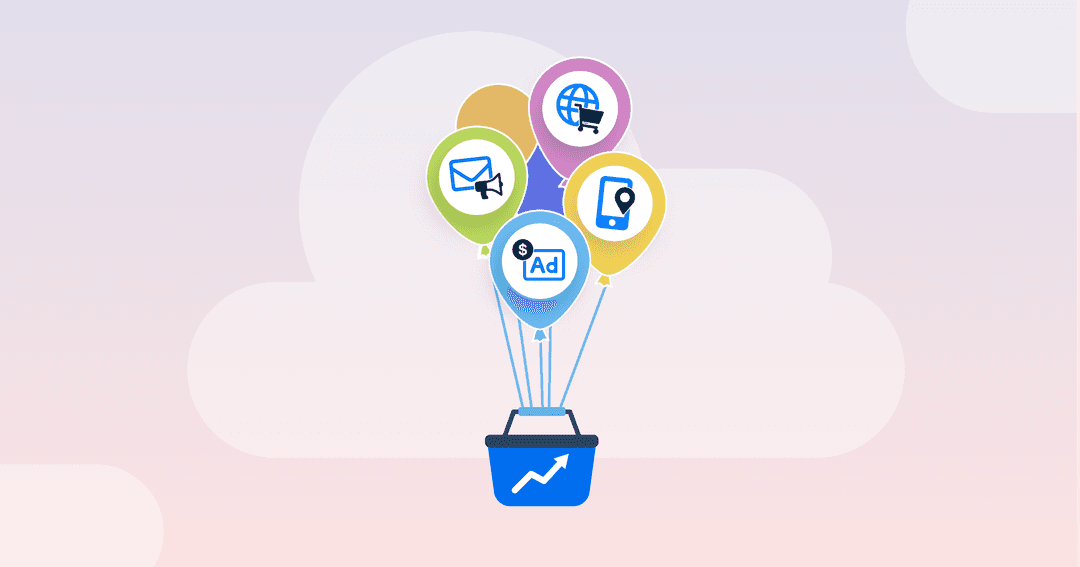Table of Contents
Table of Contents
- What Is Digital Marketing Analytics
- The Relationship Between Digital Marketing and Analytics
- How to Use the A.P.I.E. Framework To Turn Marketing Analytics Into Growth Opportunities
- Digital Marketing Analytics Vs. Web Analytics
- Actionable Analytics Vs. Vanity Metrics
- 31 Best Digital Marketing Analytics To Track
- Using Digital Marketing Analytics Tools To Bring It All Together
- Summary & Key Takeaways
7,000+ agencies have ditched manual reports. You can too.
Free 14-Day TrialQUICK SUMMARY:
Digital marketing analytics provides critical insights into customer interactions with online content, guiding content and campaign optimization. This field encompasses data from websites, social media, and advertising, essential for measuring campaign effectiveness and informing strategic decisions. Centralizing these analytics on a dashboard simplifies monitoring, ensuring a focused approach to the most impactful metrics.
As a digital marketing agency, you're always on the lookout for new and innovative ways to measure the success of your marketing campaigns. And while there are hundreds (if not thousands) of digital marketing metrics that you can track, not all of them are going to be relevant or actionable when it comes to optimizing and reporting on client campaigns.
It’s important to not let your clients get bogged down by too many stats while keeping a finger on the pulse for the metrics that matter most to your clients’ overall success.
In this article, we'll narrow it down to 31 digital marketing analytics that actually matter to an agency–and their client-facing reports. These digital marketing data points will help you understand how your clients' businesses are performing online, and which areas you need to focus your efforts on in order to reach your targets. You can even use our web analytics report template to easily report on the right web KPI's to clients.
What Is Digital Marketing Analytics
Digital marketing analytics encompasses a comprehensive approach to gathering, analyzing, and leveraging data from various digital platforms. It involves using digital analytics tools or web analytics tools to measure and interpret the interactions of users with online content, including websites, social media, and digital advertising campaigns.
This analytical process enables agencies to understand and optimize how customers respond to their clients' online marketing efforts. By employing data analytics, agencies sift through both external data (like click-through rates, engagement metrics, and conversion rates) and internal customer data (such as customer behavior and preferences) to develop a robust understanding of customer dynamics.
Leveraging digital marketing analytics goes beyond mere data collection. It's about making sense of the data to drive strategic marketing decisions. By analyzing trends and patterns, agencies tailor their strategies to better meet customer needs, predict future behaviors, and ultimately improve the effectiveness of digital marketing campaigns.
In practice, analytics in digital marketing serves as a compass, guiding marketing actions and investment. It serves as the backbone of a data-driven approach to marketing, enabling agencies to make informed decisions, achieve better results for their clients, and continuously refine their marketing tactics.
The Relationship Between Digital Marketing and Analytics
Digital marketing and marketing analytics go hand-in-hand. You need to be able to measure and track your results so that you optimize your marketing campaigns accordingly.
There is a quote that almost every marketer has come across during their career.
If it cannot be measured, it cannot be managed.
— Peter Drucker.
But with so many different metrics and data points available, it can be difficult to know which ones are actually worth paying attention to.
Let’s take a moment to dispel the myth that just because marketing is digital, everything can be measured and understood.
There's still an element of art to digital marketing, and - despite what Mr. Drucker said - not everything can (or should) be quantified. Even the most experienced digital marketing agencies will end up with a situation where a change in performance (whether that be an increase or decrease) has its roots firmly hidden, deep in the data.
Why is it difficult to answer some client questions about digital marketing performance, even with an arsenal of digital marketing analytics to track and measure?
The answer is that digital marketing is still an inexact science. The best digital marketing agencies know this, but that can be difficult to explain to clients.
While there are a lot of individual digital marketing metrics available, sometimes the process of connecting the dots between client actions and conversions is difficult. Even in 2022.
For example, digital marketing analytics may tell you that conversion rates have dipped over the last 6 weeks, but there may not be a clear reason why. That’s because the cause is not always measurable.
It could be something with the user flow (which is easier to identify), it could be competitor behavior that is attracting more of your client's prospects (harder to identify), or it could be an external influence such as world events or economic pressure that your agency has no control over (even harder to identify).
It is wrong to suppose that if you can’t measure it, you can’t manage it – a costly myth.
— W. Edwards Deming
Rather than trying to measure and report on every data point under the sun, what you can do is create clear and intuitive client reports that highlight the important digital analytics that showcase:
How well that you understand your client's business
The results you are driving on their behalf
How your agency is using its specialized capabilities to benefit the client
The progress being made on critical projects and marketing campaigns
Creative solutions to current marketing challenges
That you are staying within budget and timelines
How to Use the A.P.I.E. Framework To Turn Marketing Analytics Into Growth Opportunities
The A.P.I.E method is a framework that can be used to help clients grow their businesses. It stands for Assess, Plan, Implement, and Evaluate.
By using the A.P.I.E method, digital marketers can improve their clients’ digital marketing campaigns so they are more effective and efficient. This method can be used for both digital marketing analytics and web analytics.
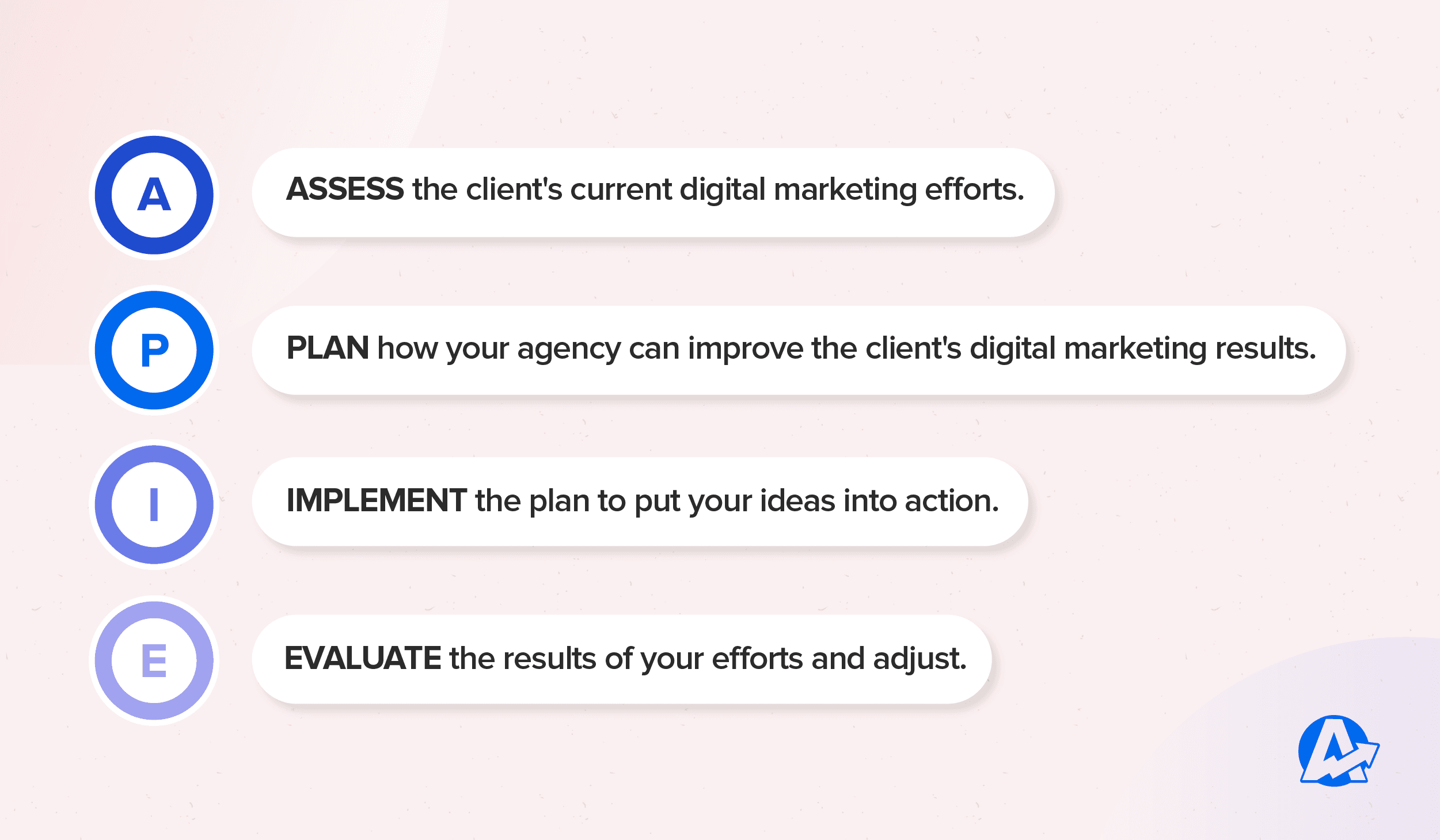
Assess: The first step is to assess the client's current digital marketing efforts. This can be done by looking at data from digital marketing analytics and web analytics. Are you trying to solve problems that the client is currently having with their SEO or campaign performance? Or are they on a solid trajectory and are looking to your agency to help bring them to the next level? This is a great opportunity to put benchmarks in place and establish a projected growth forecast.
Plan: The next step is to plan how your agency can improve the client's digital marketing efforts and results. This may include changes to the digital marketing campaigns, the client's website, or both. The details of this plan will help create a roadmap for your agency to follow, while understanding and expecting that new opportunities and issues will arise during the process.
Implement: Once the plan is complete, now is the time to put it into action. Make sure to keep annotations on when key steps in the plan were executed so that you measure the impact of each element.
Evaluate: The final step is to evaluate the results of the digital marketing campaigns and make changes as needed. Did things get better? If so, by how much and what were the key drivers of that improvement? If not, why not?
The great thing about A.P.I.E. is that it is a repeatable and iterative process that uses digital marketing analytics as a starting point for creating ongoing improvements. It is also a tool you can use to scale your agency by showing your expertise in preliminary assessment to land more clients with an SEO proposal.
If your agency isn’t a fan of that framework, S.M.A.R.T. goals are always a go-to alternative for setting expectations both with the team and with clients.
Either one of these frameworks will help your agency turn digital marketing analytics into actionable plans.
Digital Marketing Analytics Vs. Web Analytics
Digital marketing analytics and web analytics are interconnected but are two different things. The main difference between digital marketing analytics and web analytics is that digital marketing analytics focuses on marketing campaigns, while web analytics focuses on website traffic.
Digital marketing analytics is the process of measuring, managing, and analyzing digital marketing campaigns to increase their effectiveness, and broadens the scope to include everything that happens within your client's digital ecosystem. This can include social media, organic search, paid search, programmatic advertising, and more.
Web analytics, on the other hand, is limited to measuring and analyzing visitors to your client's website. It is part of the digital marketing world, but a tighter view of what happens once the connection between the potential customer and the client's website has already been made.
Actionable Analytics Vs. Vanity Metrics
Before we get into the 31 most important digital marketing analytics to an agency, it's important to understand the difference between actionable metrics and vanity metrics.
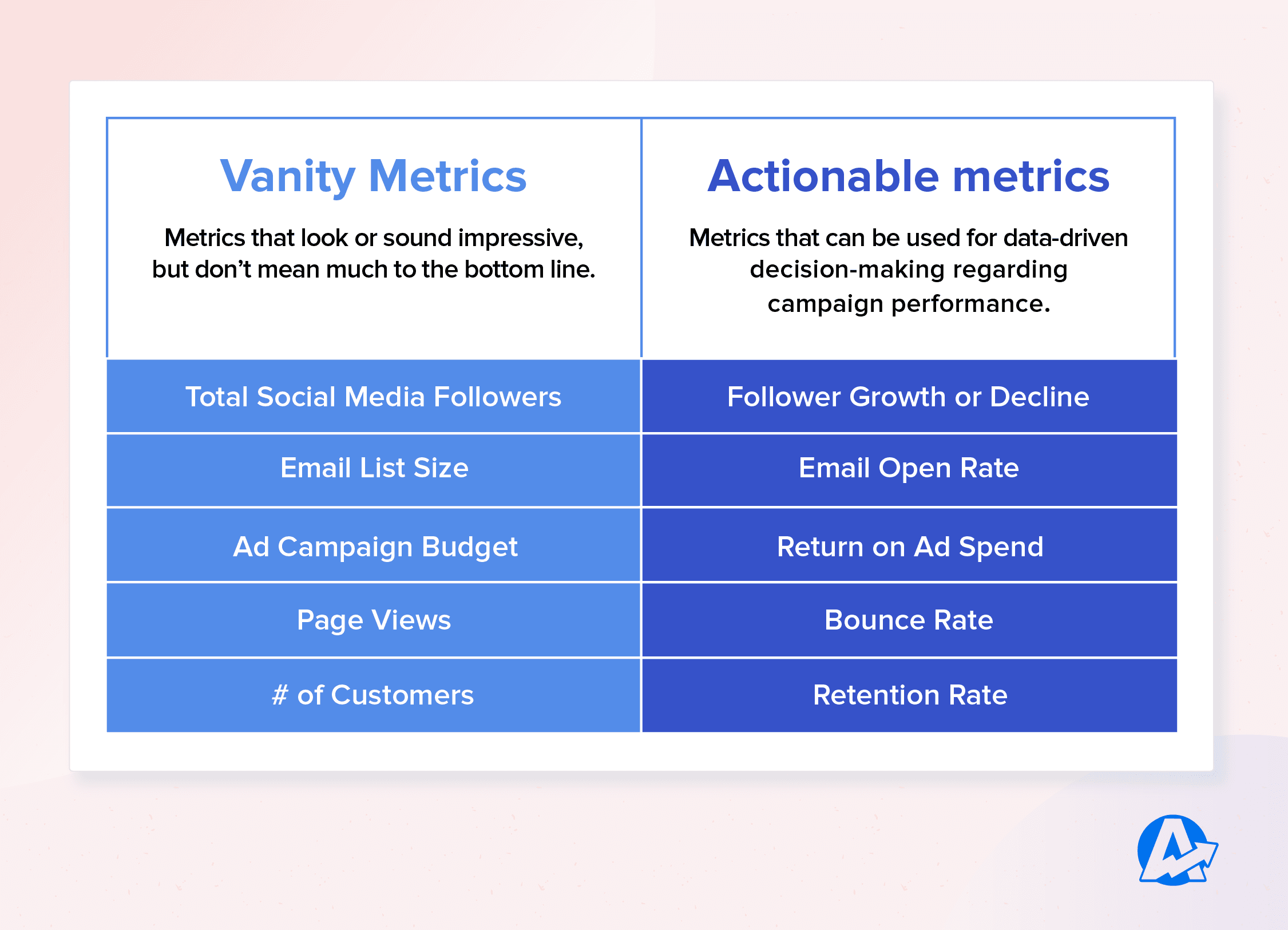
Actionable metrics are those data points that provide insights into how well your client's marketing campaigns are performing. They help you understand whether or not you're meeting set goals and provide insights that can help you improve results.
On the other hand, vanity metrics are data points that don't really tell you anything useful about your client’s business or their marketing campaigns. They might make you or your client feel good (hence the name) but they don't provide relevant insights.
Ex: Is your goal generating more leads from your client's website? A relevant metric would be the number of leads that you generated last month or the lead capture conversion rate from the landing page. A vanity metric may be the total number of subscribers, no matter what their age or status, currently in the database.
All metrics are proxies for what ultimately matters.
— Harvard Business Review
31 Best Digital Marketing Analytics To Track
If you're looking for actionable insights that can help you improve your client's results, then these are the digital marketing analytics you should be tracking in your digital marketing reporting tool. To help, we've classified these based on 7 fundamental types of digital marketing analytics, including:
1. Website and eCommerce Analytics
Tracking these core digital marketing analytics will ensure your agency isn’t planning marketing campaigns in the dark.
Website Visitors
The first metric on our list is website traffic. It is one of the most basic yet the most fundamental digital marketing analytics. Use this data to understand which channels are driving the most traffic to your client's site, and which ones need more attention. As with many of these upper-level marketing analytics, the pure number is less relevant than the details–be that the trends, patterns, customer behavior, and sources.
There are several ways that this particular data point can be broken down, including sessions, unique visitors, page views, and unique page views.
Each has its own advantage, but the most important one is sessions. Sessions inform your agency about how many times people visited the client's website, and when people come back over and over again.
It's the equivalent of foot traffic in traditional retail and gives a high-level view of the amount of interest your agency is driving in the client's brand. If you want to narrow those numbers down to the addressable audience, that’s where the “unique” version of these metrics comes into play, as that data point excludes repeat visits by the same person.
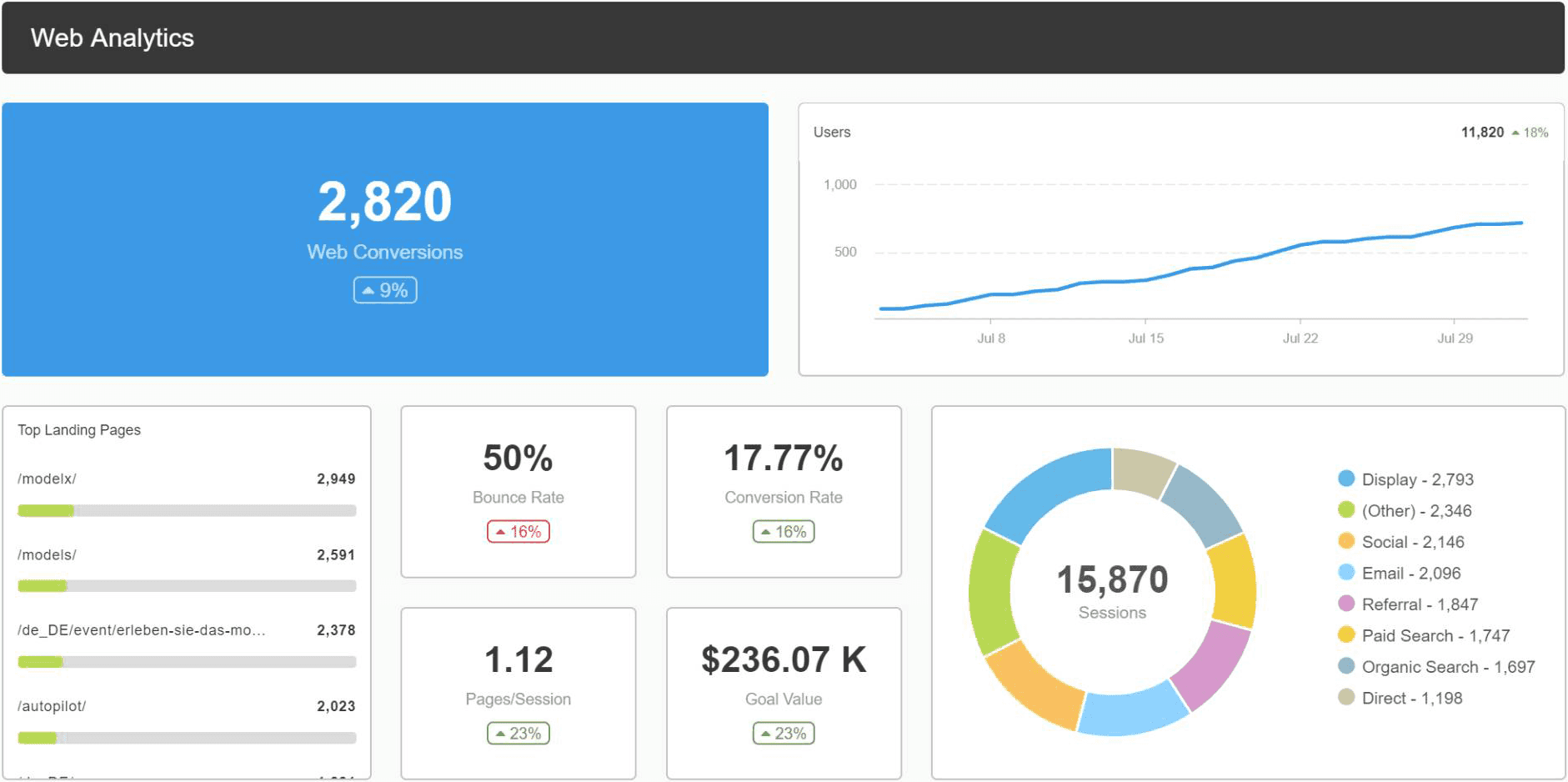
Track the digital marketing analytics that matter most to your clients with our website analytics dashboard. Test it out with a 14-day free trial.
Bounce Rate
Bounce rate gives you a clear indication of how well the site is engaging visitors. In order to put them into context, bounce rates need to be sliced up a little bit to compare your client's performance against industry benchmarks. For example, bounce rates in GA-4 tend to vary by device, industry, and content type.
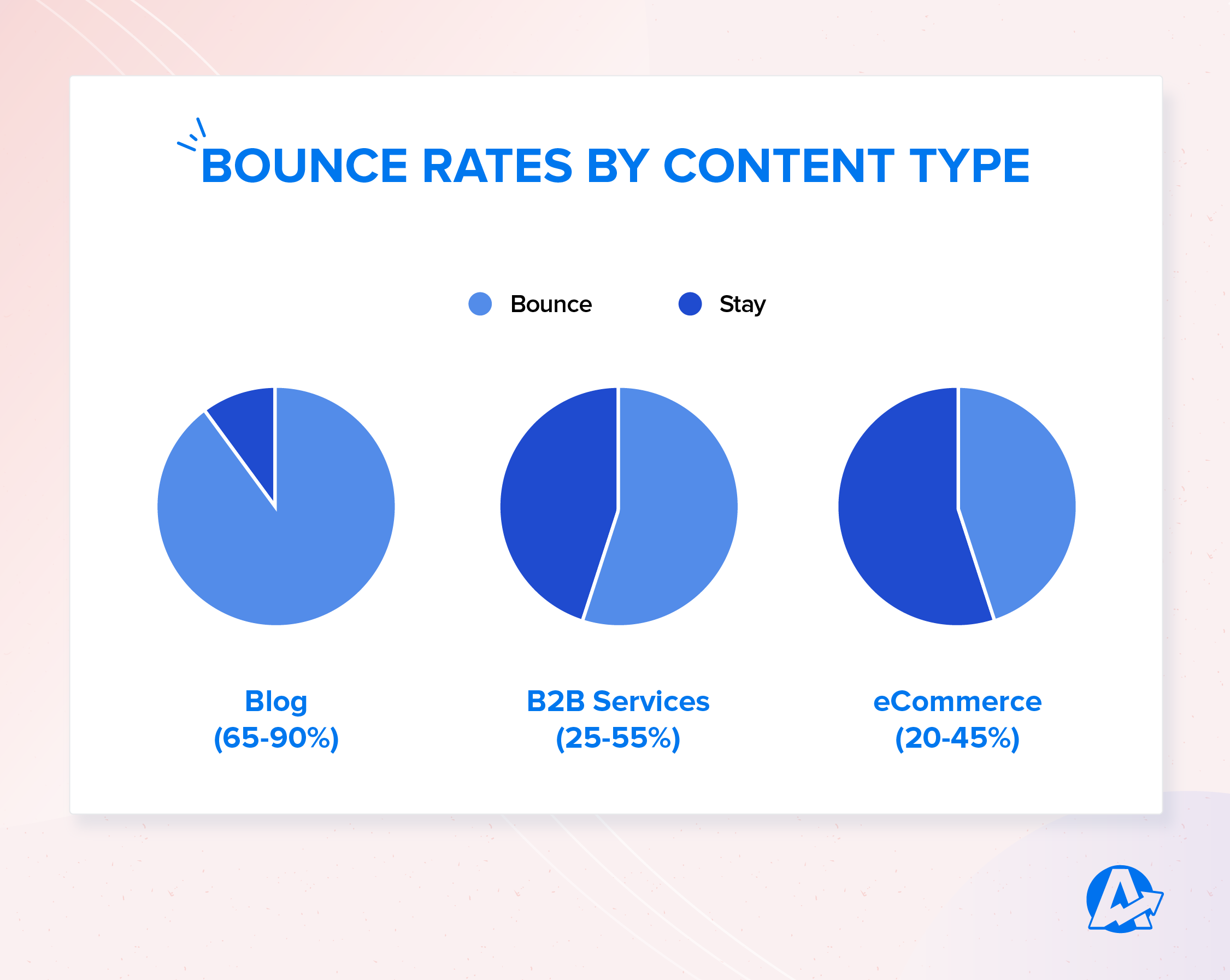
So, if your agency is running a content marketing campaign for a real estate agency, you need to factor those two elements into play to set a realistic benchmark for blog bounce rate.
Conversions & Goals
Now we start digging into the real purpose of any digital marketing program: conversions. Many agencies focus exclusively on sales as the conversion point, but when doing so-they risk missing out on some growth opportunities. Understanding the different conversion actions, including micro-conversions, will help your team paint a clear picture of how well your client campaigns are reaching the target audience in different ways.
Goals are often considered a subset of conversions because the user can achieve certain goals without having to actively submit any kind of form or order.
Agency Tip: If your client is launching a new product, a conversion could be signing up for a pre-launch announcement email, but a goal could be watching the teaser video. Set custom goals to monitor the progress against both of these KPIs (Key Performance Indicators).
Gathering your digital marketing analytics data from Google Analytics and presenting it in a way that makes sense to your clients can be tedious and time-consuming… but we’ll get into that later.
Conversion Rate
Digging one step deeper, the conversion rate tells you how many people are taking the desired action out of the total number of people who visited your client's website. What's more important, however, is if that conversion rate is improving or declining over time.
Conversion rates are important because they give you an indication of five key conversion drivers:
The right audience
The right product
The right user experience
The right message
The right time
There are several ways to improve conversion rates, including A/B testing, optimizing webpage designs, and improving the customer experience.
Revenue
Ensuring that your client's digital marketing efforts are driving revenue is, of course, the ultimate goal. But it's also one of the most difficult metrics to track accurately–at least when it comes to cause and effect. That's because there are so many factors that can influence revenue such as pricing changes, seasonality, economic conditions, and customer journey.
Plus, revenue tracking brings in an entirely different conversation regarding digital marketing attribution models. This is an area where I have seen many heated debates over which channel gets to claim a particular conversion.
For example, there are several options within Google Ads for how your agency or your client wants to attribute what campaign drove which action, from first click (which gives it all to the first interaction) to last click (which attributes the conversion to the last touchpoint) and a wide variety in between.

In the end, it's part of the agency's role to understand the revenue being driven by particular marketing campaigns–including how those campaigns support each other in achieving the overall revenue objective.
Acquisition Channels
To properly understand web traffic, a digital marketing agency needs to dig into channel marketing and web analytics to figure out where that traffic is coming from, and how that compares to some industry benchmarks. Typically, the largest drivers of traffic are Direct and Organic, followed by Paid Search and Referrals. Of course, those numbers can fluctuate based on the maturity of the website, client focus, and the marketing budget, but it’s good to understand the eCommerce averages for context.
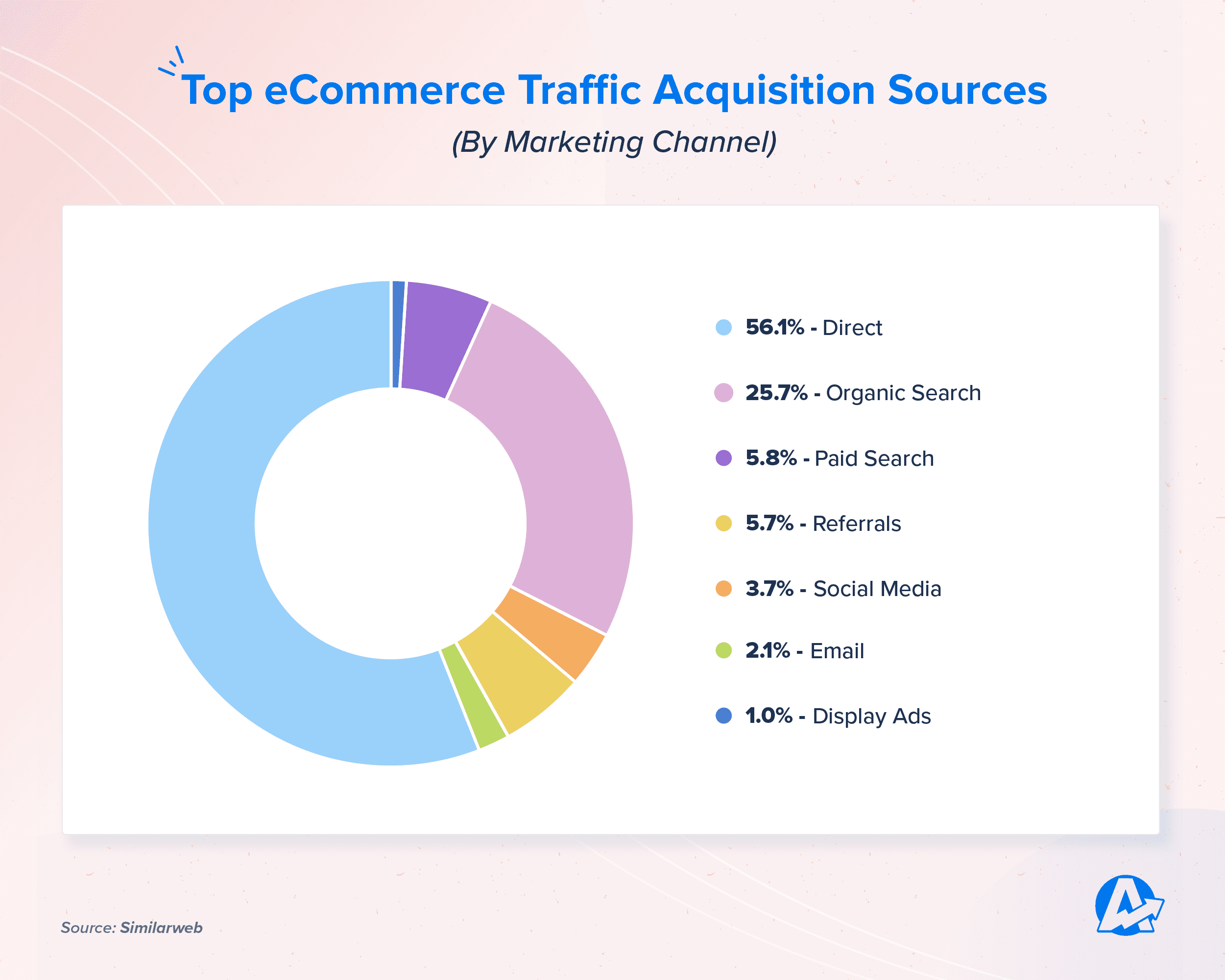
For example, if the client is in more of a startup mode, your agency will likely need to rely more heavily on external sources such as paid ads and social media while the brand awareness and site authority are being built. Over time, the reliance on paid as a percentage of total sales will be reduced–either naturally as the other channels increase, or purposefully–by shifting the budget away from under-performing channels.
Agencies and clients typically rely on a variety of channels to drive the total business, so your agency needs to keep your finger on the pulse of all of them, even if you aren’t managing them all for them (yet).
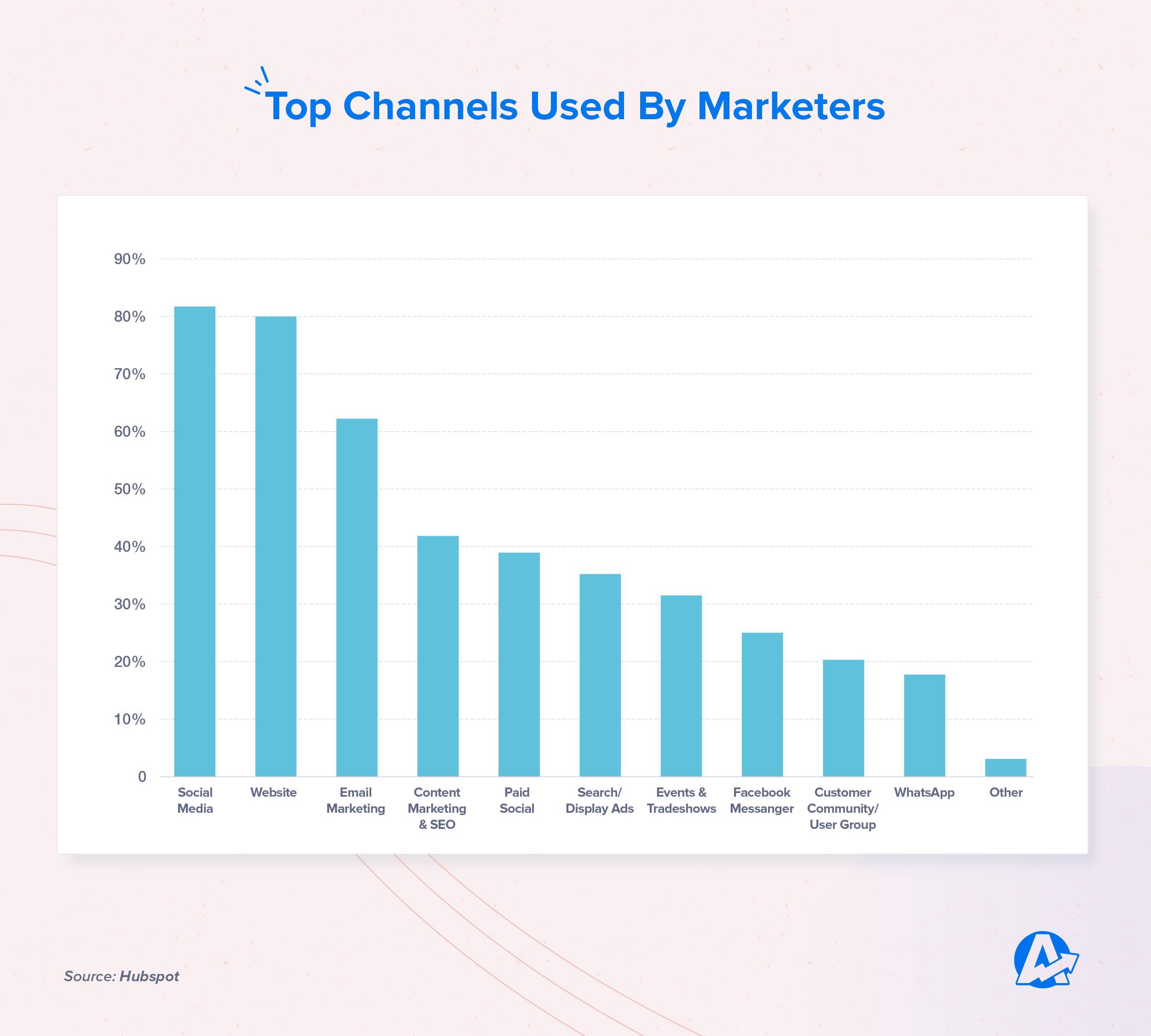
Source: Hubspot
You may also like 15+ Most Important Ecommerce Metrics & KPIs to Measure Client Success
2. SEO Analytics
If search engine optimization is a key focus for your client's marketing campaigns, then these are the digital marketing analytics that you need to be tracking. Even if your focus is not on SEO, SEO analytics are important metrics to track. Setting up SEO reports for clients only takes a few minutes, and they'll give you insights into how well your SEO efforts are paying off, highlight the long-term benefits of the SEO work you're doing, and pinpoint where you need to focus your attention in order to improve results.
Organic Traffic
Organic traffic will help showcase how well your team’s SEO strategies are paying off over time. The organic world tends to be a long haul, so you can’t expect these numbers to skyrocket immediately upon launch. But it’s all about if that channel is trending in the right direction.

Part of that organic traffic data includes digging deeper into the visitor behavior once they get to your client's website, including bounce rate, time spent on the page, and new versus returning visitors to make sure your agency is engaging with the right audience.
Create a comprehensive SEO dashboard in minutes. Try AgencyAnalytics free for 14 days!
SEO Site Health
Tracking SEO site health provides an overall score, as well as detailed information about each of the key factors that influence SEO site health, such as page speed, mobile-friendliness, common SEO errors, and more.
Read more about how to perform an SEO Health Checkup.
Domain Authority
Your client’s Domain Authority score is a good metric to keep an eye on because it can be used to predict changes in search engine rankings. 100 is a maximum reachable score, but the chances of getting to that top mark are pretty slim. Google.com, the absolute leader in search, has an Authority Score of 99, so if Google can't get to 100, who can? Even SEMrush only has an authority score of 79 based on its own tool.
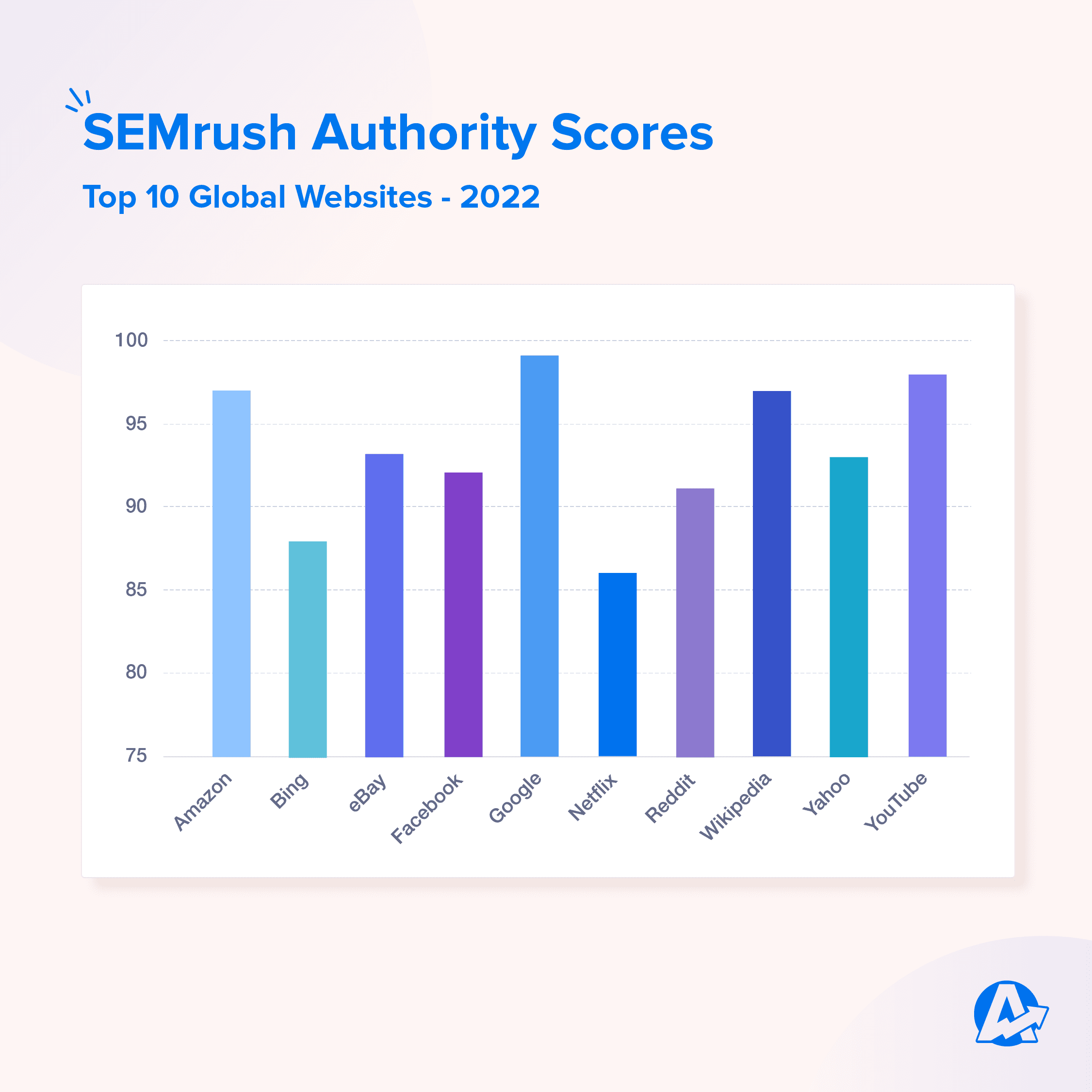
And, of course, the lowest possible Authority Score–which is usually only seen with brand new sites with minimal content and no backlinks-would be a starting score of 0.
This is a helpful guide to help answer the common questions agencies can get, such as:
Is my authority score any good?
When can we get the authority score to 90?
Why didn't our authority score increase last month?
DA Score | What It Means |
0-19 | Typically assigned to a new site with minimal content, social shares, or backlinks. If you are doing consistent SEO and content work, you should see this number grow a little bit each month. However, it can take a few months (post-launch) to see any initial gains in authority score. And don't be surprised if things plateau for a few months during the process. |
20 - 39 | This means your agency is making some headway in supporting a new (or previously ignored) website. Although this is a perfectly acceptable range for a local or niche-focused business with minimal online competition. A lot of agencies get stuck in this range, so it's important to break into the 40+ range if you want to start tackling some more competitive keywords. |
40 - 59 | This is the sweet spot for many agencies working with small businesses. This means that your agency is doing a great job in developing the overall domain authority of the site! No matter how hard you try, you may never be able to move your client's Authority Score needle above the 59 mark. |
60 - 79 | You're in elite company. Only a small percentage of websites have an Authority Score in this range. Part of this is because achieving authority score gains at the lower level is much easier. Once your client's website hits this range, getting even a one-point increase will take far more effort than gaining a 10-point gain when you're at the first level. |
80+ | You're among the best of the best. These ranges are typically only held by well-known brands or enterprise companies. |
Keyword Rankings
The higher the ranking, the more likely people are to find and click on your client's site. There are a number of different SEO rank tracking tools available to track keyword rankings, but we-of course-highly recommend the AgencyAnalytics keyword rank tracker.

A powerful keyword rank tracking & reporting tool. Intuitive, data-driven keyword reports for you and your clients. Try it free for 14 days!
Have strong rankings that aren't generating enough traffic? This could be an issue with the keyword volume or the click-through rate on the results page. If it's the CTR, try adjusting the title and meta description to make sure you are giving searchers a compelling reason to click on your client's link.
Backlinks Generated
Backlinks are an important element of any SEO effort. Keep track of new and lost links with a comprehensive backlink monitor tool. Analyze key backlink metrics such as anchor text, Trust Flow, and Citation Flow to see not just how many backlinks your client is getting, but also how good those links are.
These are all important metrics not only for your agency to optimize results but also for making the client feel like their investment in SEO is paying off. According to the HubSpot State of Marketing Report, some of the ways that businesses measure the success of an SEO strategy are based on the following key metrics:

Read more about the important SEO metrics to track.
3. Email Marketing Analytics
Email is still one of the most effective marketing channels available with the highest conversion rates, with contacts that keep giving back.
Email List Growth
Email list growth is important to include within your agency’s digital marketing analytics because it represents your ability to increase the size of the client's audience and reach more potential customers. Additionally, email list growth can also help agencies influence other marketing channels, such as SEO and social media, by creating a multi-funnel approach to acquiring more customers.
If, for example, the immediate return on ad spend between Facebook Ads and Google Ads is exactly the same, but Facebook Ads is driving four times the number of email signups, that's a good indication that more budget should be shifted over to Facebook.
Although both are driving the same number of current customers and revenue, this data would indicate that Facebook is also driving higher potential for future revenue by getting subscribers to connect with your client's brand.
Email Response Rates
Sending the right message to the right people at the right time is essential for any email marketing campaign. But, if you're not tracking email response rates, you won't know how well your messages are being received.

Email response rates can be tracked in a number of ways, including open rate and click-through rate. Additionally, many email marketing platforms will provide detailed information about where people are clicking within your emails (e.g., links, images, buttons), as well as which devices and browsers they're using.
This data can be extremely helpful in understanding what's working (and what's not) in your client email marketing campaigns so that you make necessary adjustments.
Email Deliverability
Email deliverability is another important email metric to track, as it indicates whether or not your emails are actually making it into people's inboxes. There are a number of factors that can impact email deliverability, such as spam filters, blacklists, and bounced emails.
Additionally, many email providers (e.g., Gmail, Yahoo, etc.) are constantly changing their algorithms, which can also impact deliverability. Therefore, it's important to keep an eye on this metric and make sure that your emails are getting delivered to the people who need to see them.
Unsubscribe Rate
It’s almost impossible to send an email campaign without having at least a small percentage of recipients unsubscribe. But if you find that number creeping up above past averages or email marketing benchmarks, it could mean that your messaging is not as relevant to the potential customer as your client would like.
A 2021 report by Campaign Monitor tagged the average email unsubscribe rate at 0.1%, but even those fluctuated wildly based on the industry with healthcare services coming in among the highest (at 0.3%) and retail coming in closer to the industry average.
But why do those people that your agency worked so hard to get onto the client’s email list end up leaving? According to Hubspot’s State of Marketing Report, more than half of the people who unsubscribe do so because they are being contacted too frequently.

The trick is to understand what, exactly, “too frequently” means to your client’s target audience. Is daily too often? In most cases, the answer to that question is going to be yes. But what about weekly? Or monthly? That will depend more on your client, the email content, and the target audience’s appetite to receive it.
Read more about important Email campaign metrics.
4. Social Media Marketing Analytics
Social media is a key part of any digital marketing strategy, and these digital marketing analytics will help you understand how well your client's social media marketing campaigns are performing.
Engaged Social Followers
Tracking social followers is important to a marketing agency because it helps them understand the reach and influence of their client's social media marketing campaigns. However, the total number of followers is less important than the follower trends (are they gaining or losing followers) and engagement. Tracking social follower growth can help agencies identify which social media platforms are most effective for their clients, as well as which types of content are performing best.
Post Engagement
Post engagement is a metric that measures the interactions people have with a piece of content on social media. This can include Likes, Comments, Shares, and Clicks.
Although sometimes considered a vanity metric, engagement is important to track because it gives you an indication of how well your content is performing and whether or not people are actually interested in what you are posting on behalf of your client.

Keep an eye on critical social media marketing analytics across multiple platforms with one easy-to-use social media dashboard. Try AgencyAnalytics free for 14 days.
Best Posting Times
There really is no set “best time” to post on social media, as it can depend on a number of factors ranging from the behavior of the target audience to the brand being promoted. Typically, these times will be identified over time through testing. But, if you’re wondering where to start, Sprout Social suggests the following posting times are best for driving engagement on various social media platforms.
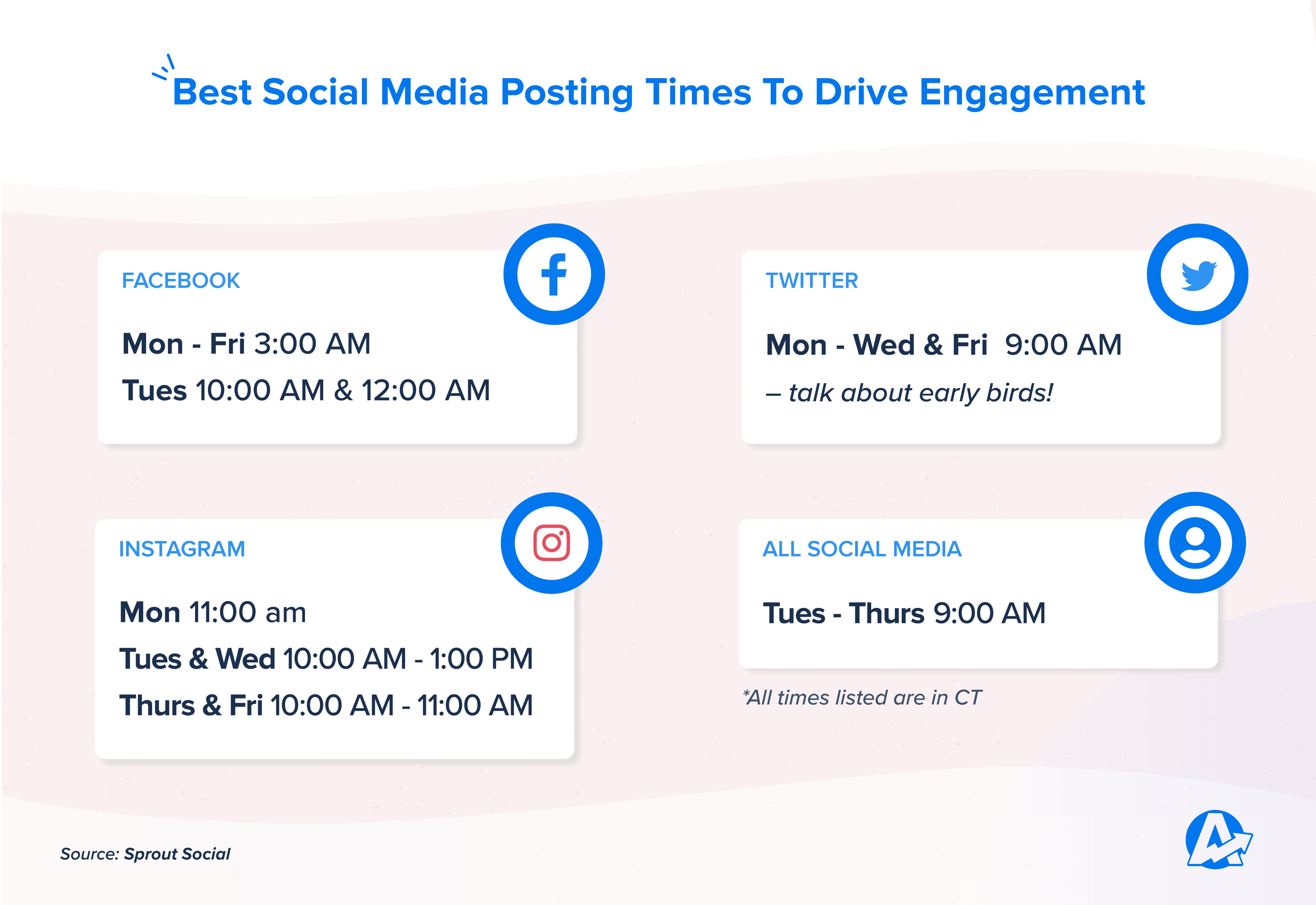
Read Next: The Ultimate Guide to Social Media Analytics.
5. Paid Ad (PPC) Analytics
Paid search analytics data can help agencies optimize their ad campaigns to ensure that they are getting the most bang for their client's buck. After all, if you aren’t spending your client’s ad dollars efficiently, they likely won’t be your clients for very long.
Cost
Implementing a paid ad campaign can be expensive, so it's important to track the cost of your client's marketing campaigns to make sure you stay on budget. Although the total budget may be considered a vanity metric, attempts to stay on budget should not be done in vain.
Agency Tip: Setting your client’s budget up as a custom goal will help keep your agency aligned on the total monthly spend.
CTR (Click-Through-Rate)
CTR measures the effectiveness of a paid ad campaign. The calculation is very straightforward (clicks divided by the total number of impressions) so there is little room for interpretation with this metric.
Simply put, a high CTR indicates that people are interested in the content of your ads and they are relevant to the keywords being targeted, at least enough so to convince the searcher to click to learn more.
Agency Tip: Although CTR is less important than some other metrics, it can be an indicator of ad quality or keyword targeting issues that will lead to increased costs.
CPC (Cost Per Click)
CPC is the amount you pay each time someone clicks on one of your client's ads. This metric is-in essence-the foundation of the cost metric, as the higher you're willing to pay per click, the higher your daily spend will most likely become.
Agency Tip: Don't get caught up in a bidding war to win positions for keywords that don't perform well for clients. Focus on the bottom line and adjust the CPCs accordingly.
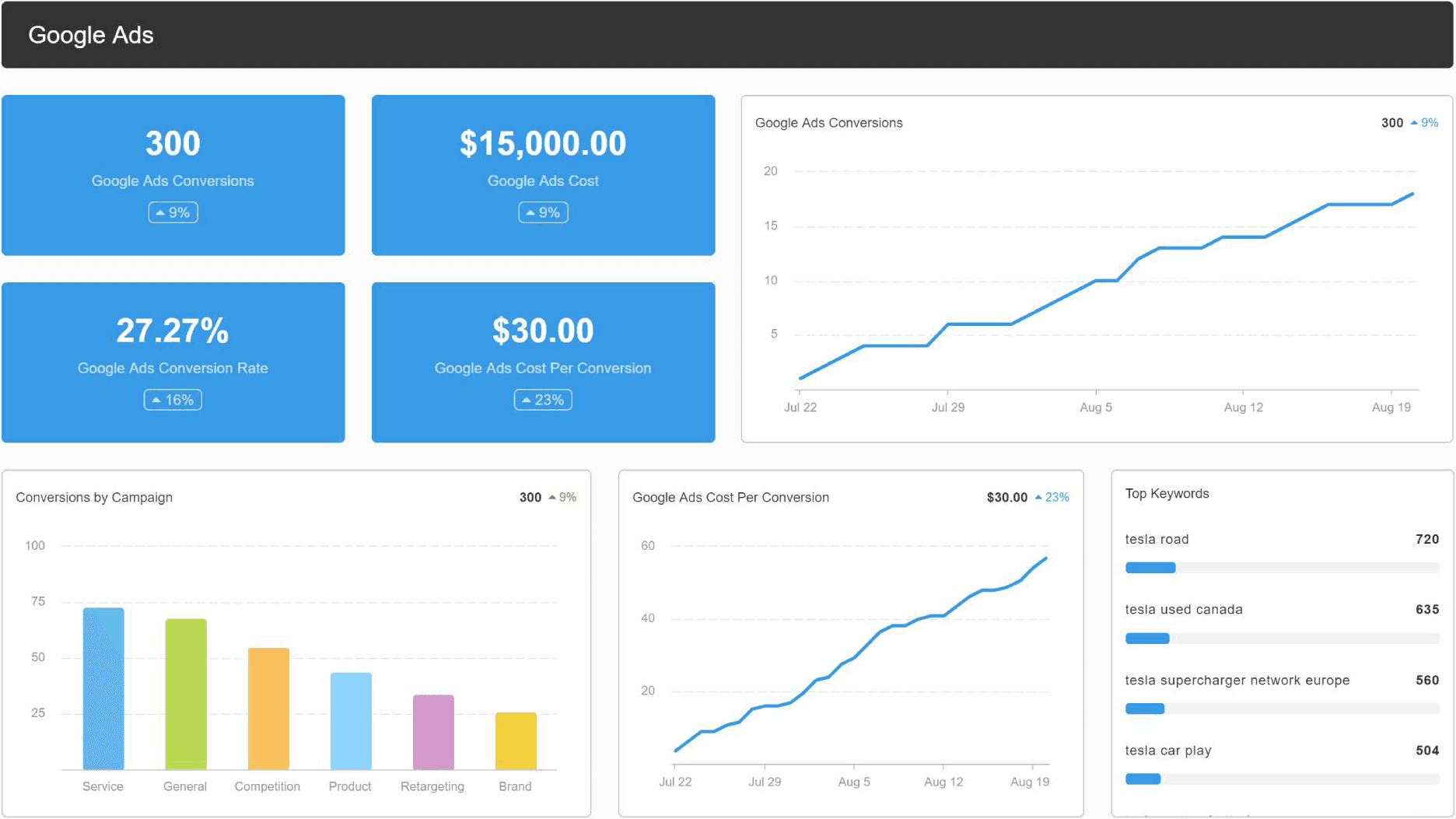
Use the AgencyAnalytics PPC dashboard to consolidate and monitor key metrics from all your clients’ PPC marketing campaigns. Try it free for 14 days!
CPA (Cost-Per-Action)
CPA is the amount you end up paying for the successful completion of a tracked action on your client's site, such as making a purchase or signing up for a newsletter. This metric can be helpful in understanding how effective your ad campaigns are at not only driving impressions and clicks but also driving the right kinds of impressions and clicks… the kind that leads to conversions.
The COVID-19 pandemic caused a significant shift in a lot of digital marketing metrics, and CPA was among those impacted. Surprisingly, the average cost per acquisition on Bing has crept above that of Google, although Bing Shopping is still a fairly cost-effective bet.

ROAS (Return on Ad Spend)
The ROAS metric takes CPA to the next level by adding the amount of revenue generated to the picture. This lets your agency compare the amount spent to acquire a customer to the amount of revenue generated.
Although the industry average ROAS on Google Ads is 200% (or 2x), as an agency it's important to have clear guidance on the ROAS targets your client is seeking. Are they willing to take a loss on the first purchase to acquire a long-term customer, or do they need to be profitable on that order right away? That information helps your agency determine what is and what is not a good ROAS target for your campaign spend.
Want to dig deeper into Google Ads Metrics? Read 11 Critical Google Ads Metrics Agencies Should Monitor Daily!
6. Local Marketing Analytics
In many ways, these metrics are similar to others included in this post. But there is much more of a focus on the local details than you might see in general digital marketing analytics. These include:
Local SEO Metrics - Including localized search rankings, and NAP placements (Name, Address, Phone Number) within local business directories.
Local Search PPC Metrics - Such as targeted marketing campaigns and GLSA campaign performance.
Local Social Media Metrics - Standard likes, follows, and shares but with a focus on local content & engagement.
Reviews & Reputation Management - Review reports track a company's reputation within the community.
Usage of Maps & Directions - Are users able to find the local business within maps so that they can easily locate the closest outlet?
And, of course, Call Tracking - which leads us to the next key digital marketing analytics category…

Working with a local client? You might also enjoy reading How To Create Local Marketing Reports.
7. Call Tracking Analytics
Call tracking is important to digital marketing agencies because it allows them to track how effective their client's digital campaigns are at driving offline behavior.
By using a call tracking app and tracking the number of calls that are generated by each campaign, marketing agencies can determine which marketing campaigns are generating the most leads and revenue. This data can then be used to adjust future campaigns accordingly
Call Volume
Relatively self-explanatory, this is the pure and top-level view of the total number of calls generated by your client campaigns. Phone calls are extremely valuable to clients, especially those within the services space who focus on high-value customers. If someone calls your client, they are typically ready to buy. Marketing Dive notes that lead inbound phone calls convert anywhere from 25 to 40%. Compare that to the average conversion rate of a lead form at 2% and you can see that calls turn prospects into buyers at a rate 12 to 20 times higher than lead forms.
Not paying attention to increases in call volume or–worst case–declines can cost your client and your agency dearly.
Call Source
Of course, any call tracking analytics would be incomplete without understanding what source drove the call in the first place. This way, your agency can clearly see which campaigns and platforms are driving those all-important phone calls and focus on the greatest areas of opportunity.
With a dedicated Call Tracking dashboard, collect data and report on the results in real-time. Take AgencyAnalytics for a test drive with a 14-day free trial!
Call Status
Just because someone placed a call to your client doesn't mean that the connection was completed. It's important to understand if the calls being generated by your client campaigns are being answered. That way, you dig into issues or patterns and adjust as needed.
For example, if the client operates from 9 a.m. to 5 p.m., but you have call-driving campaigns running after hours, those calls will likely go unanswered. And unanswered calls can mean lost customers.
Want to know how your client compares to some call center industry benchmarks? According to a recent study by Call Centre Helper, the average handling times for the most common touchpoints include:
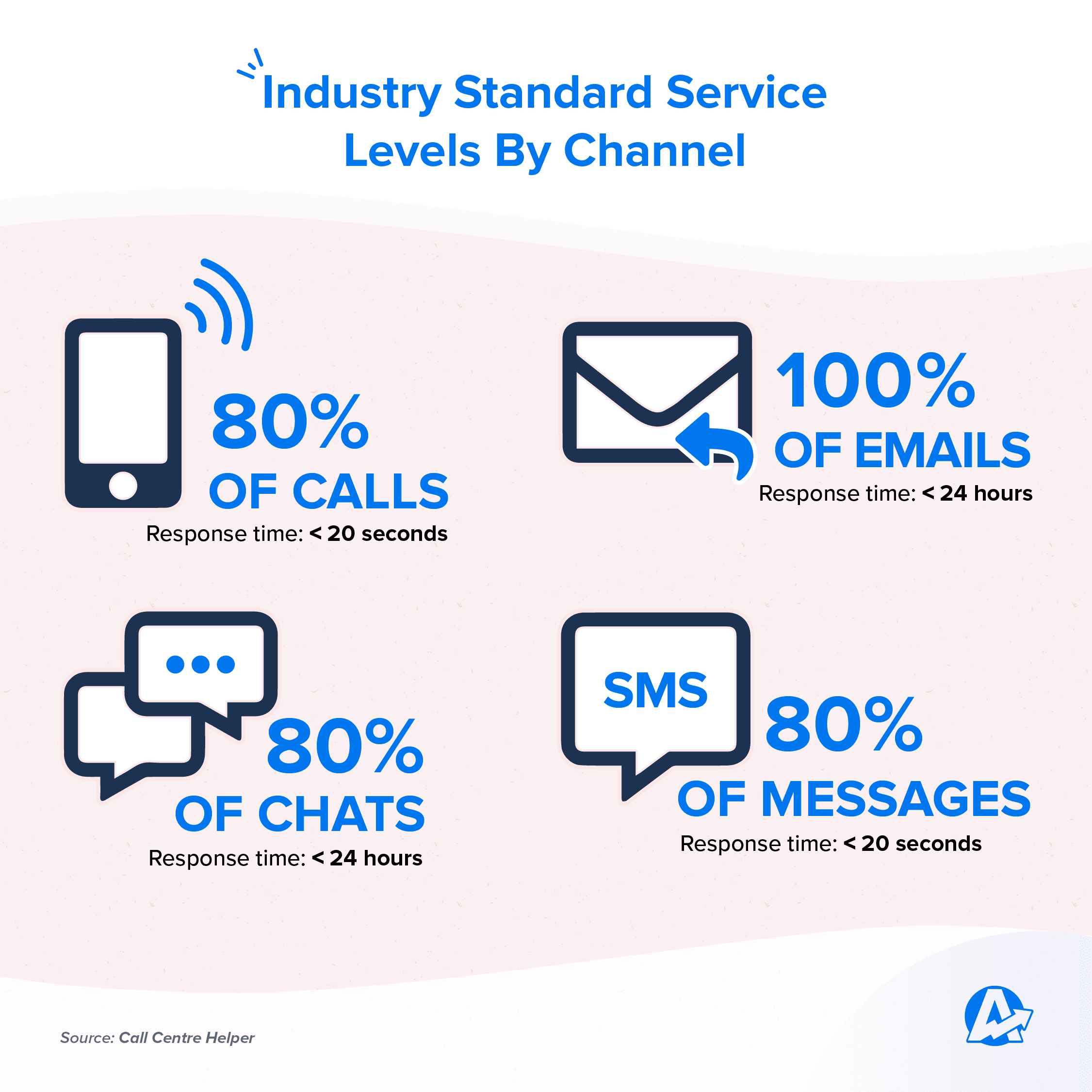
You may have noticed that Social Media is not included in those industry benchmarks. That’s because the study found too much of a variance between participants to be able to nail down an industry average.
Check out this article for more information: Call Tracking Analytics: The Top 5 Metrics You Should Track
Using Digital Marketing Analytics Tools To Bring It All Together
One of the biggest challenges with digital marketing analytics is the sheer breadth and depth of information that is available across dozens of different platforms. That’s where the right digital marketing analytics tools come into play.
The best and easiest way to create reports that clients can understand is to integrate and analyze your marketing data in one place. A digital marketing report template further streamlines that process, ensuring you gather the right digital marketing analytics, metrics, and insights to report the results to clients in a fraction of the time
From customer data, progress against business goals, audience demographics, results of strategic marketing activities, and more… there is always plenty of information to slice and dice while performing data analysis.
But the key to creating powerful digital marketing reports for busy marketing professionals defining which marketing and digital analytics are essential to your agency and your client. And then bringing them all together in a centralized platform.
Tracking your client campaign progress across your social media, PPC, SEO, and other marketing channels can require hours-even days-spent logging in and out of different platforms, copying data, compiling it, adding visualizations, and summarizing actionable insights, before sending it off to the client.
All that time spent simply pulling big data together is time not spent optimizing client campaigns or onboarding new clients.
The best and easiest way to create reports that clients can understand is to integrate and analyze your marketing data in one place.
The good news is that a digital marketing dashboard streamlines that entire process so you easily gather digital marketing analytics, metrics, and insights to report the results to clients in a fraction of the time.
AgencyAnalytics has provided a robust portal for our major marketing analytics to share with our clients. I love that we can white label the dashboard to create a branded experience for our clients.
-Michael Anderson, The Wonderist Agency
With this digital marketing dashboard, your agency marketing team will track key marketing metrics like ad spend, SEO keyword rank, conversion rate, revenue, and much more from a single, real-time platform. Not already an AgencyAnalytics customer? Try the platform free for 14 days to see for yourself!
Summary & Key Takeaways
An agency has to care about digital marketing analytics because it helps them measure the effectiveness of their client's campaigns, make data-driven decisions to improve their performance, and showcase results to their clients. To wrap things up, here are the key takeaways from this article:
There is a wide range of digital marketing analytics available at any given moment. So much so, that it's easy to get overwhelmed by the big data from your client's website, paid ad campaigns, email campaigns, automation, social media, and more.
If you narrow your agency's focus to the 31 digital marketing analytics that actually matter–and then drill deeper into the metrics when needed–you keep a stronger finger on the pulse of all your client campaigns.
A digital marketing dashboard streamlines the process of gathering all of these different metrics and digital marketing analytics from various platforms into one central location.
What other digital marketing analytics do you think are important for agencies to track? Join the conversation on LinkedIn or Facebook!

Written by
Paul Stainton is a digital marketing leader with extensive experience creating brand value through digital transformation, eCommerce strategies, brand strategy, and go-to-market execution.
Read more posts by Paul StaintonSee how 7,000+ marketing agencies help clients win
Free 14-day trial. No credit card required.


